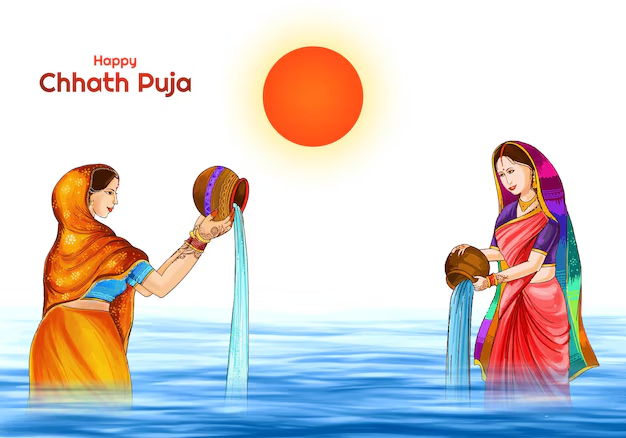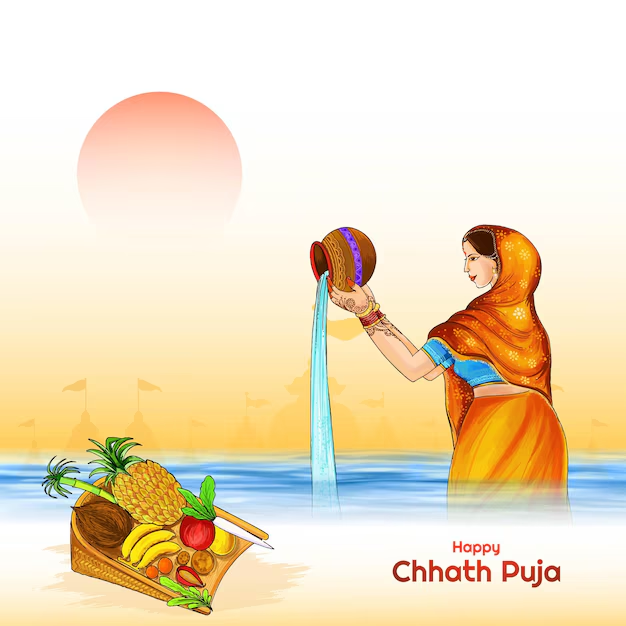Chhath Puja: A Sacred Festival of Devotion and Worship of the Sun God
Chhath Puja is one of the most significant and ancient festivals celebrated primarily in the Indian states of Bihar, Jharkhand, Uttar Pradesh, and parts of Nepal. Known for its grandeur and cultural importance, this festival is dedicated to worshiping the Sun God (Surya) and Chhathi Maiya (Mother of the Six Seasons). Taking place six days after Diwali, Chhath Puja is a unique occasion where devotees express gratitude to the Sun for sustaining life on Earth and pray for blessings, health, and prosperity. This article delves into the significance, rituals, traditions, and historical background of Chhath Puja, giving you a comprehensive understanding of this revered festival.

What is Chhath Puja?
Chhath Puja is a Hindu festival celebrated over four days, marked by rigorous fasting, abstinence from drinking water, and offering prayers to the rising and setting Sun. It is a time for people to connect with nature and express gratitude for all the blessings provided by the Sun. The festival also includes rituals that promote personal and communal well-being, with people gathering at rivers, ponds, and lakes to perform the rituals in a collective spirit of devotion.
The Origin and History of Chhath Puja
The origins of Chhath Puja can be traced back to ancient Hindu texts and legends. It is believed that the rituals of Chhath Puja date back to the Vedic period when sages worshipped the Sun to harness its energy. Another legend is associated with the Mahabharata, where Draupadi and the Pandavas performed Chhath Puja to gain blessings for victory in their struggles.
The significance of Chhath Puja is also rooted in ancient science. The festival promotes a connection to nature, purity, and healthy practices, such as abstinence from processed food and water. By observing the festival, devotees practice discipline, self-control, and dedication, strengthening both the mind and body.
Significance of Worshiping the Sun in Chhath Puja
The Sun is revered as a source of life and energy in Hindu culture. Known as the provider of vitality, health, and prosperity, the Sun god is worshipped during Chhath Puja to thank him for his generosity. Chhath Puja is a rare occasion where the Sun is worshipped in both rising and setting forms. Devotees offer prayers during the dawn and dusk hours, as these are considered the most auspicious times to connect with the divine energy of the Sun.
The festival also honors Chhathi Maiya, who is regarded as the goddess who protects children and ensures their health and happiness. By paying homage to Chhathi Maiya, families pray for the well-being of their loved ones and the prosperity of their communities.

The Four-Day Rituals of Chhath Puja
Chhath Puja is celebrated with a four-day series of rituals and ceremonies, each day carrying special significance. The entire process of Chhath Puja is marked by immense dedication, purity, and sincerity among devotees.
Day 1: Nahay Khay (Bath and Eat)
On the first day, devotees purify themselves by taking a dip in holy rivers or ponds. This ritual, called Nahay Khay, signifies the beginning of the puja with a focus on internal and external purity. After bathing, they prepare a vegetarian meal, which is typically shared with family members. The diet on this day is simple, often consisting of rice, dal (lentils), and pumpkin cooked in ghee. This meal marks the start of the puja with clean, unprocessed foods, symbolizing purification and simplicity.
Day 2: Kharna (Fasting)
The second day of Chhath Puja, known as Kharna, involves a rigorous fasting process. Devotees abstain from food and water throughout the day. In the evening, they prepare a special meal of kheer (a sweet rice pudding made with jaggery), bananas, and puris, which is offered to the Sun before it is consumed. This meal is shared with family and friends, symbolizing community unity and the act of giving.
The Kharna meal is highly symbolic, representing the end of day-long fasting and the offering of the first “prasad” or sacrament to the Sun.
Day 3: Sandhya Arghya (Evening Offering)
The third day is considered the most important part of Chhath Puja. Devotees fast for a full day, even abstaining from water, and gather at riverbanks to offer “Arghya” to the setting Sun. This ritual, known as Sandhya Arghya, involves offering water and milk to the Sun during sunset. Devotees stand waist-deep in water and perform this ritual with great devotion. Women commonly wear traditional sarees, and the air is filled with devotional songs praising the Sun and Chhathi Maiya.
At dusk, families come together to celebrate and pray for peace, prosperity, and health. This day is especially sacred, as it is believed that offerings made to the setting Sun cleanse devotees of their sins and bring positive energy to their lives.
Day 4: Usha Arghya (Morning Offering) and Parana (Breaking the Fast)
The final day of Chhath Puja begins before dawn as devotees offer “Usha Arghya” to the rising Sun. This offering is made with similar devotion, as the rising Sun is believed to represent hope, renewal, and blessings for the future. People gather once again by rivers and lakes, singing songs and performing traditional rituals in a joyful atmosphere.
After completing the morning offering, devotees break their fast, marking the end of the Chhath Puja. The breaking of the fast, or Parana, is done by sharing prasad with family and friends, symbolizing the culmination of worship and gratitude toward the Sun god.
Key Ingredients and Offerings in Chhath Puja
The prasad and offerings during Chhath Puja are as important as the rituals themselves. The main ingredients used include thekua, fruits, and vegetables, which are locally sourced and considered pure. Thekua, a sweet made from wheat flour, jaggery, and ghee, is especially popular and is an essential prasad for Chhath Puja.
Apart from thekua, other offerings include rice, sugarcane, coconuts, bananas, and various seasonal fruits. These items are placed in bamboo baskets and offered during the rituals, symbolizing abundance, gratitude, and a connection to nature.
Environmental Significance of Chhath Puja
Chhath Puja is an eco-friendly festival that encourages people to honor natural resources and maintain cleanliness in water bodies. The rituals, performed at riverbanks and lakes, foster a communal responsibility to keep these resources pure. Additionally, the offerings used in Chhath Puja are biodegradable and cause no harm to the environment, further reflecting the harmonious relationship between humans and nature.
The festival promotes an awareness of environmental conservation and demonstrates how traditional practices can contribute to ecological balance.
Why Chhath Puja is Celebrated with Devotion and Reverence
Chhath Puja is celebrated with unparalleled dedication, reflecting the deep-rooted respect for natural elements in Hindu culture. The ritualistic fasting, prayers, and offerings showcase the resilience, patience, and discipline of devotees who seek blessings for their families and communities. The festival is not only a spiritual journey but also a social one that brings families together, strengthens community bonds, and reinforces the importance of harmony with nature.
Chhath Puja is a festival that transcends mere rituals, embodying values of humility, gratitude, and respect for the forces that sustain life on Earth.
